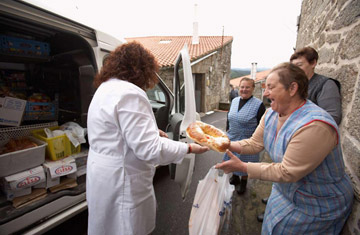
BREAKING BREAD: Buying freshly baked breads from the Pan de Cerdedo bakery truck. Every home in Vilar has its own bread oven now only used for storage.
Photo Essay: Galician Village
Carmen Iglesias de Filgueiras, my husband Alberto's grandmother, is 95 this year. She lives in a fogbound corner of northwest Spain, in the same farmhouse where she was born. Her mother, grandmother and at least a dozen others were also born in that house, but after 300 years the family tree gets tangled in memory, even one as sharp as hers. Señora Carmen has lived to see the 21st century, but she lives too deep in the rural mountains of Galicia for most of it to have reached her. Visiting Vilar, her tiny village, is like traveling back in time; dining there gives a rare taste of a vanishing way of life.
Getting to Vilar means taking the road to nowhere. The navigation system doesn't know where the village is, and it takes us down a random dirt road that dead-ends at a derelict water tower. This failure of satnav technology underscores the feeling that Vilar exists in a different dimension. Today, it has only 46 residents. Even in its heyday, it was never big enough to warrant a church or even a proper name. Vilar simply means "village," and there are dozens of Vilars. Nobody ever passes through Señora Carmen's Vilar; the road to Vilar doesn't go beyond it, merely looping back toward Cerdedo, the largest nearby town. Behind the village rise wooded hills given over to wild boars and wilder horses. There are no hotels or restaurants, not even a corner store. To go to Vilar, let alone eat there, you'd have to know family as well as the lay of the land.
We have to look sharp for the left turn to Vilar. We know we've overshot it when we pass a minuscule Romanesque chapel half buried in the forest. A sign says the Capilla of Santa Lucia is 18th century, but that's probably just the last time anyone fixed it up. There is a beautiful moss-covered cruceiro, a Galician double-sided stone cross, and rumors of a Madonna dating to the 12th century or so. We have a lovely photo of Alberto's Aunt Olivia as a bride here, but now the chapel is a burned-out ruin. A small carved figure blesses the entrance, but its features have been lost to age. Who knew stone could wrinkle?
The road also goes by the parish church of San Martiño. Alberto's parents got married here before they emigrated to South America. His great-great-grandfather, a builder, placed the cross on the steeple. Back then, workplace insurance consisted of the priest praying for divine protection while the mason scaled the granite pinnacles without a safety harness. Now there is only one priest for four parishes, and the vicarage has caved in. Only one house in San Martiño is inhabited, but the churchyard is crowded with Vilar family graves.
Half a kilometer uphill, the living town and its traditional way of life grow a little more ghostly with each visit, but even Father Time moves more slowly here. The older folks always warn us that they might have moved to San Martiño by our next visit, but except for Señora Carmen's friend Divina who was taken off to her daughter's home, they are all still here. Some are sitting at the bus stop, not looking a day over 70. I have yet to see a bus come through here, but the shady bench is a popular hangout. For a place where nothing ever happens, there's always plenty of gossip.
We're eager to get to Señora Carmen's house, but we can't go across town without stopping to greet everyone and figure out how we are connected. Since almost everyone is related, this takes a while. My Japanese face and odd accent make me a Martian, but no one says anything except, "Welcome back, what's kept you so long, and have you gained weight?" It's a rare privilege to enter this social circle, normally suspicious of outsiders. Alberto is scarcely less foreign since he was raised in Caracas, but he gets a native son's welcome. "Don't you recognize me? Your father's father, may he rest in peace, was the brother of my father!" says the newly restored Great-Uncle Oudilio Torres Simal. "You teased that donkey until he kicked you," says a doll-sized woman. "You had it coming." The fact that it's been 30 years since that incident means nothing.
Alberto towers over his Vilar kin, most of whom saw at least one world war and the hungry times of the Spanish Civil War. Alberto's dad suspects he once ate a cat that someone palmed off as rabbit. Cat is no longer on the menu, and the food is once again hearty farm fare. At Señora Carmen's house, we know that there is a huge spread simmering on the wood-fired iron stove. Alberto's grandmother, neatly coiffed and dressed in black except for a checkered apron, sits in the warmest kitchen corner. Her niece Gloria Simal Iglesias expertly swirls batter for lacy filloas, or Galician crepes. Behind her bubbles a pot of cocido gallego.
Gloria has worked hard on this cocido. The garbanzos, potatoes, onions and kale came from her garden, the meat from the pig she slaughtered at Christmas. The chicken is in fact a rooster, which had until recently ruled the yard; only the veal was purchased for the occasion. She even made the wine, well sugared to take off the roughest edges. No meal could be a purer expression of Vilar's terroir since the whole thing was produced within a few dozen meters of where it will be consumed, by people who have been eating cocido in this room for generations. This is no time to worry about calories. In Vilar, cocido is more than dinner. It's a ritual verging on sacrament, a labor of love in a pot.